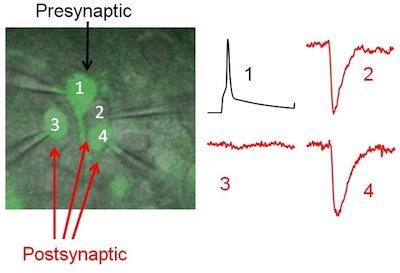People
Principal Investigator

Jay Gibson, Ph.D.
Faculty Profile
Associate Professor
Phone:214-648-5133
Lab: 214-648-5131
Fax: 214-648-1801
Email
Current Lab Staff
Phone: 214-648-5131
Technicians
Former Students
Research Interests
Dr. Gibson's current research focuses on the changes in neocortical circuitry in the mouse model of Fragile X Syndrome (the Fmr1 KO mouse), and the mechanisms underlying these changes. The work primarily employs electrophysiological techniques in brain slices.
Dr. Gibson has made numerous discoveries regarding the altered function of neurons and synaptic pathways in this mouse. One general hypothesis for autism and Fragile X Syndrome is that there is a change in the excitation-to-inhibition balance in neocortical networks, and as a result, they are hyperexcitable. In the Fmr1 KO, the Gibson Lab was the first to observe specific forms of hyperexcitability and de-synchronization in neocortical network function that is due specifically to changes in the neocortex (Gibson et al., 2008, Hays et al., 2011).
Dr. Gibson's work indicates that Fmr1 deletion in neocortical excitatory neurons, and not inhibitory neurons, causes these changes. And he has found that enhanced metabotropic glutamate receptor signaling and altered Homer protein scaffolding are biochemical alterations in the Fmr1 KO that underlie hyperexcitability (Hays et al., 2011; Ronesi et al., 2012).
He has discovered synaptic and connectivity alterations that may underlie hyperexcitability and de-synchrony. Presynaptic FMRP promotes synaptic release probability at excitatory synapses contacting the most common inhibitory neuron in the neocortex – the fast-spiking, parvalbumin-positive neuron. Consequently, in the Fmr1 KO mouse, excitation of fast-spiking neurons is decreased due to a decrease in release probability (Gibson et al., 2008; Patel et al., 2013).
In more recent work, the Gibson Lab has developed an experimental model of synaptic pruning in layer 5A neocortical pyramidal neurons and has used this model to demonstrate that loss of FMRP specifically impairs developmental pruning resulting in hyperconnectivity. As a result, excess recurrent excitation and network hyperexcitability may occur (Patel et al., 2014). One long-term goal is to determine if there are common underlying neuronal circuit changes in various forms of autism.
 Recording pre- and post-synaptic neurons in isolation
Recording pre- and post-synaptic neurons in isolation Highlighted Publications
Wilkerson, J.R., Tsai, N.P., Maksimova, M.A., Wu, H., Cabalo, N.P., Loerwald, K.W., Dictenberg, J.B., Gibson, J.R, Huber, K.M. (2014) A Role for Dendritic mGluR5-Mediated Local Translation of Arc/Arg3.1 in MEF2-Dependent Synapse Elimination. Cell Rep., 7(5):1589-600.
Patel, A.B., Loerwald, K., Huber, K.M., and Gibson, J.R. (2014) Postsynaptic FMRP promotes the pruning of cell-to-cell connections among pyramidal neurons in the L5A neocortical network. J. Neurosci., 34(9):3413-3418. PMID:24573297
Jakkamsetti, V., Tsai, N-P., Gross, C., Molinaro, G., Collins, K.A., Nicoletti, F., Wang, K.H., Osten, P., Bassell, G.J., Gibson, J.R., and Huber, K.M. (2013) Experience-induced Arc/Arg3.1 primes CA1 pyramidal neurons for metabotropic glutamate receptor-dependent long-term synaptic depression. Neuron, 80(1):72-79. PMID 24094104.
Patel, A.B., Hays, S.A., Bureau, I., Huber, K.M. and Gibson, J.G. (2013) A target-cell specific role for presynaptic Fmr1 in regulating glutamate release onto neocortical fast-spiking inhibitory neurons. J. Neurosci., 33(6):2593-604. PMID: 23392687.
Ronesi, J.A., Collins, K.A., Hays, S.A., Tsai, N-P., Guo, W., Birnbaum, S.G., Hu, J-H., Worley, P.F., Gibson, J.R., and Huber, K.M. (2012) Disrupted mGluR5-Homer scaffolds mediate abnormal mGluR5 signaling, circuit function, and behavior in a mouse model of Fragile X Syndrome. Nat. Neurosci., 15(3): 431-40. PMID: 22267161.
Hays, S.A., Huber, K.M. and Gibson, J.G. (2011) Altered Neocortical Rhythmic Activity States in Fmr1 KO Mice Are Due to Enhanced mGluR5 Signaling and Involve Changes in Excitatory Circuitry. J. Neurosci., 31(40):14223-34. PMID: 21976507.
Gibson, J. R., Huber, K. M., and Südhof, T. C. (2009) Neuroligin-2 deletion selectively decreases inhibitory synaptic transmission originating from fast-spiking, but not from somatostatin-positive interneurons. J. Neurosci., 29(44):13883-97. PMID: 19889999.
Gibson, J. R., Bartley, A. F., Hays, S, and Huber, K. M. (2008). An imbalance of neocortical excitation and inhibition and altered UP states reflect network hyperexcitability in the mouse model of Fragile X Syndrome. J. Neurophysiol., 100(5): 2615-2626. PMID: 18784272.
Bartley, A. F., Z. J. Huang, Huber, K. M., and Gibson, J. R. (2008) Differential activity-dependent, homeostatic plasticity of two neocortical inhibitory circuits. J. Neurophysiol., 100(4): 1983-1994. PMID: 18701752.
Chubykin, A.A., Atasoy, D., Etherton, M.R., Brose, N., Kavalali, E.T., Gibson, J.R. and Südhof, T.C. (2007) Activity-dependent validation of excitatory versus inhibitory synapses by neuroligin-1 versus neuroligin-2. Neuron 54: 919-932. PMID: 17582332.
Gibson, J.R., Bartley, A.F. and Huber, K.M. (2006) A role for the subthreshold currents ILeak and IH in the homeostatic control of excitability in neocortical somatostatin-positive inhibitory neurons. J. Neurophysiol. 96: 420-432. PMID: 16687614.
Deans, M.*, Gibson, J.R.*, Connors, B.W. and Paul, D.L. (2001) Synchronous activity of inhibitory networks in neocortex requires electrical synapses containing connexin36. Neuron 31: 477-485. PMID: 11516403.
Beierlein, M.*, Gibson, J.R.* and Connors, B.W. (2000) An electrically coupled network of interneurons drives synchronized inhibition in neocortex. Nature Neuroscience 3: 904-910. PMID: 10966621.
Gibson, J.R.*, Beierlein, M.* and Connors, B.W. (1999) Two electrically coupled inhibitory networks. Nature 402: 75-79. PMID: 10573419.
*Denotes equally contributing authors.